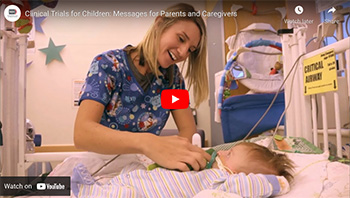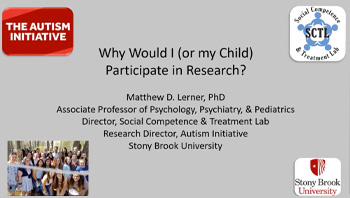Your Questions Other Helpful
Resources Stony Brook Children’s Research in the News
Did you know that over 21% of our Long Island community are children? Our kids deserve the best choices in medicine and life, just like adults. Researchers can help children by including them in clinical trials or other studies for new ideas. That way, we can find treatments for conditions that kids experience – not just adults.
OUR EXPERT ANSWERS YOUR QUESTIONS
 | Sharon Nachman, MD Director, Division of Pediatric Infectious Diseases Director, Office of Clinical Trials Active Researcher for clinical trials of promising medicines |
Research is the lifeblood of medicine. Clinical Research is when we test new medical ideas from the lab, and see if they work in real people – we call these investigations Clinical Trials, or Studies.
It helps us move the practice of medicine forward.
Clinical research helps us see if our lab discoveries work in people. Will they help to identify or prevent - or even cure someone with a specific disease? We can only know by testing our new discoveries. Without clinical research, lab discoveries would not help our patients because we wouldn’t know how to use them.
I’ve always been the person who wanted to understand the ‘why’ in medicine. Why did that medicine work? Why did it not work? How can I make it work better? Clinical research is an extension of that type of thinking.
A placebo is something that contains no medicine, similar to salt water. We use them in clinical trials when there is no existing therapy for a disease, and we’ll compare the new therapy idea to a placebo.
For example, each recent COVID vaccine clinical trial also used placebos. It was important to understand if the placebo or the new COVID vaccine being tested led to more pain, more arm tenderness, or even more fever from the injection. Having the placebo as a comparison helped us understand how often a COVID vaccine would have those side effects. Pretty much every licensed vaccine used around the world went through the same type of test in people.
In our COVID vaccine trials in children, for every 3 children enrolled, 2 get the test vaccine, and 1 gets the placebo. Every 3 children are the same pattern – and who receives placebo is by chance.
I am often asked this, and the answer is: of course not. Research often involves well people and not just sick people. There are many kinds of clinical research. Some check safety of a new test therapy, some are planned to check the best dose of a new medication, and some compare a brand-new medicine to the current therapy, or “the standard of care”.
Researchers also look at the natural history or outcome of your disease, or how to better treat disease symptoms. We also test compare new treatments against ones that everyone thinks are the best way to treat your condition, or even looking to see if a medication is really needed.
I was taking care of a 2.5-year-old toddler in the Pediatric ICU who had a multi antibiotic resistant bacterial infection.
She was doing poorly. We had no available antibiotics to treat her infection. Good news – I remembered something that might give her a chance to live.
When I first started at Stony Brook, before the ‘computer’ era, we took pencil and paper to meetings, and wrote down any new or in-development therapies. There were no electronic sources from meetings. We relied on our notes to keep track of new ideas.
This was in 1997. I kept a library of my notes just in case I would need them: new medication ideas, companies investigating them, contact information for the lead investigators, and the new mechanisms of actions of these therapies.
So, in my notes, I had data from a pharma company for a new antibiotic, which in the lab worked on these multi antibiotic-resistant strains of bacteria. The antibiotic didn’t have a name, just some letters and numbers.
There was only data in animals - none in children or adults, but I didn’t let that stop me. It was something we had to do. We couldn’t allow that child to die.
I called the company. After they got over their shock of “who are you and why are you calling me”, they said if I wrote a clinical trial plan for Compassionate Use (which means nothing else could potentially save this child), the FDA approved it, and her family agreed to give consent, they would ship me enough of their antibiotic to treat the child.
So the FDA approved of my plan, and her family said they wanted to try this to save her. The company shipped me the medication. Everyone understood that this was a chance, only. On that Saturday, I waited in my office until FedEx arrived with the important package, and then ran that antibiotic over to the ICU for our little patient. After she was dosed, I sat at her bedside with her family to see how their child would respond. It was a long wait. Amazingly, she improved! Not only did she survive that infection, but she grew up, graduated from high school AND college, and lives her life.
If we ignore studying medicines in children, we make them second class citizens; they wouldn’t have access to new therapies like adults. When they get the same diseases adults do, we want to treat them in the best way.
Because of our request to use that specific antibiotic in a child, the pharma company changed their research plan. They requested the FDA to allow inclusion of children in all future plans for that new medication. So, based on that one child we were able to study children, across the ages, and get that antibiotic licensed for use in children and not just adults. It is now routinely used in care for children around the world. That was a success.
Other Helpful Resources:
- Children and Clinical Studies
- Overview of Clinical Trials for Children
- DigiKnowIt News: A place where kids can learn about clinical trials
http://free.digiknowit.com/index.html - Sofia Learns About Research: A Coloring Book
Parents and Children can learn about research together. Follow Sofia’s journey as she considers joining a clinical trial for asthma! Download a coloring book in English, Spanish, or Arabic, or play online in this wonderful resource from the University at Buffalo.
http://www.buffalo.edu/ctsi/cores/recruitment/sofia-learns-about-research.html - The Paper Kingdom: An Interactive Game for Kids
Download and play The Paper Kingdom, a game to help kids learn about clinical studies.
https://www.childrenandclinicalstudies.org/kids-files/the-paper-kingdom/
Watch the video to learn more about the game:
https://www.youtube.com/watch?v=7WMvUE4Eups&feature=emb_rel_end



